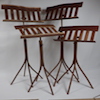I'm building 4 somewhat decorative braces to replace some that were lost. Thought I had the plan in mind of how to put all the little parts together but now that I'm actually at the point of doing it, I'm second guessing myself and could use some opinions on the best way forward. My original thought was to use dowels to give a physical bridge across the joint but I'm now thinking it might be impossible to drill all the holes properly to assure alignment. I assumed I could cobble together some sort of clamp to hold the pieces on the drill press but even if I can, I have my doubts that I can drill that many holes in end grain and get it all straight. The holes only need to be 3/16" deep. For reference the parts are 1/2" x 1/2". The dowels in pic 1 are 1/4" x 3/8" long.
20221104_155155.jpg20221104_155343.jpg
So I got to wondering if it would hold together with just glue. It is acting as a brace of sorts with potentially some minimal sideways load (from left to right). Would be hard to quantify how much load but it is not much. Then I got wondering if CA would be strong enough but figured it might not be, which then got me to thinking why not just use epoxy?
What do you all think?
Thanks!






 Reply With Quote
Reply With Quote



